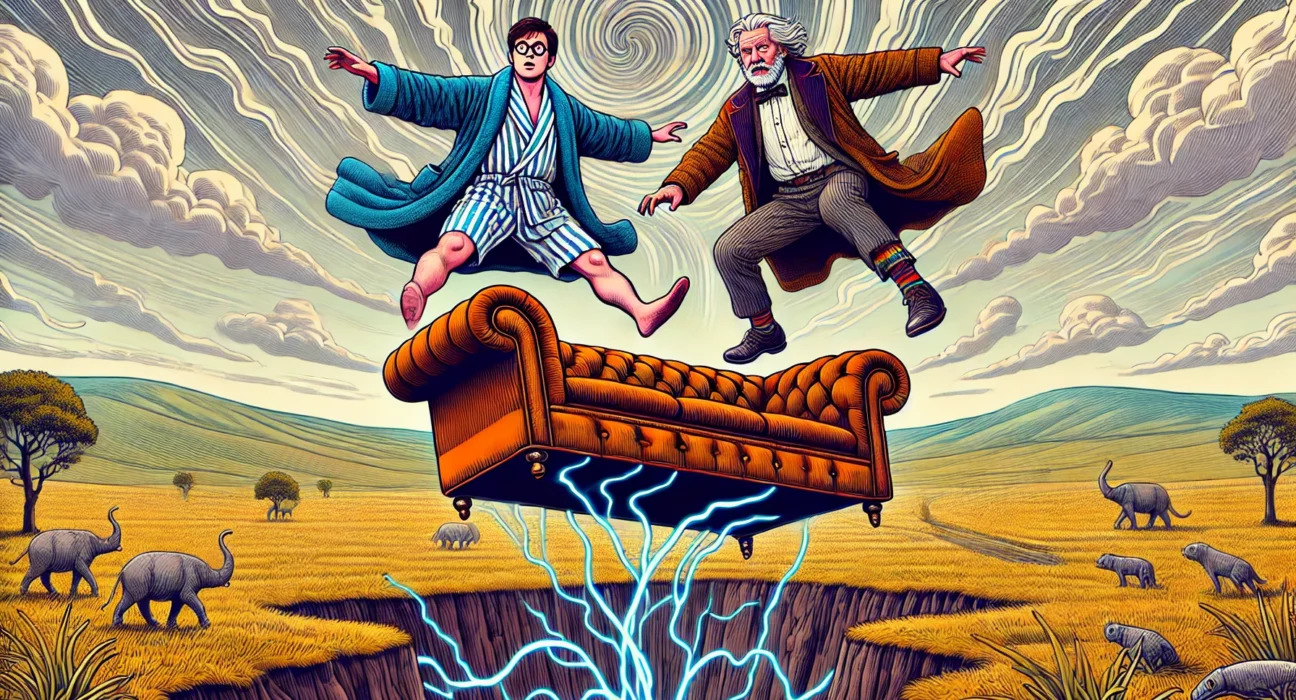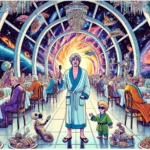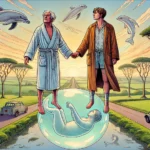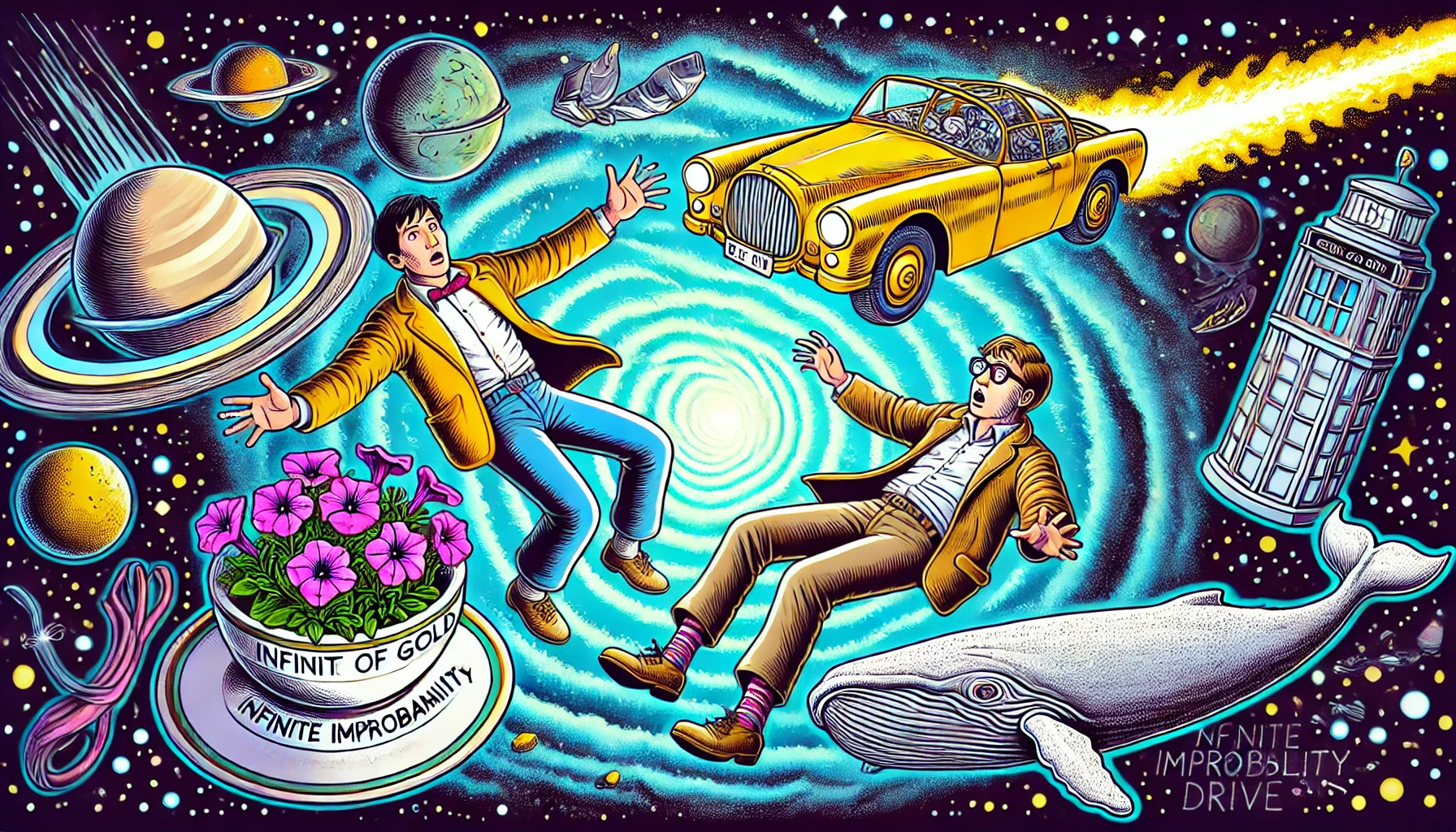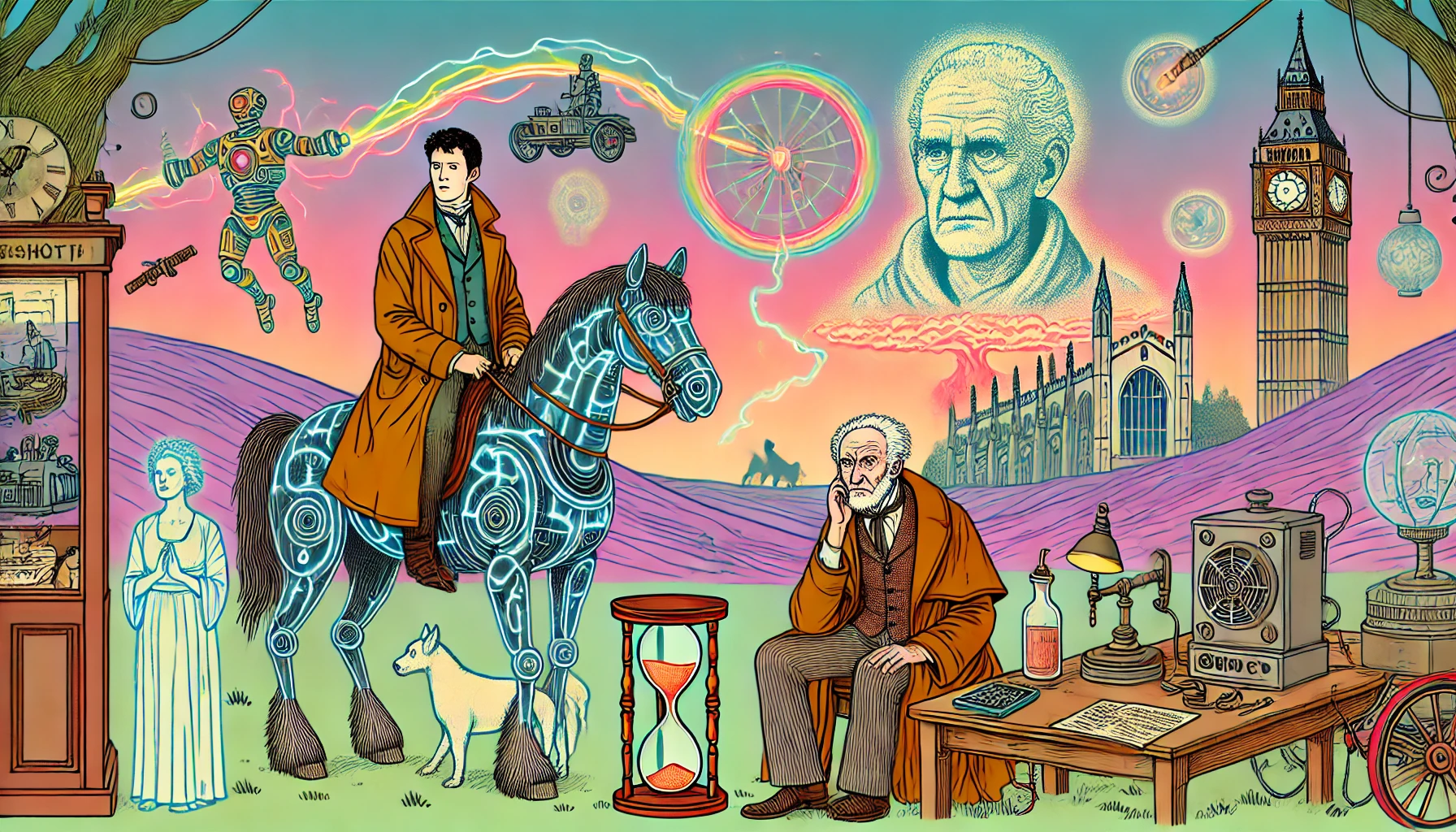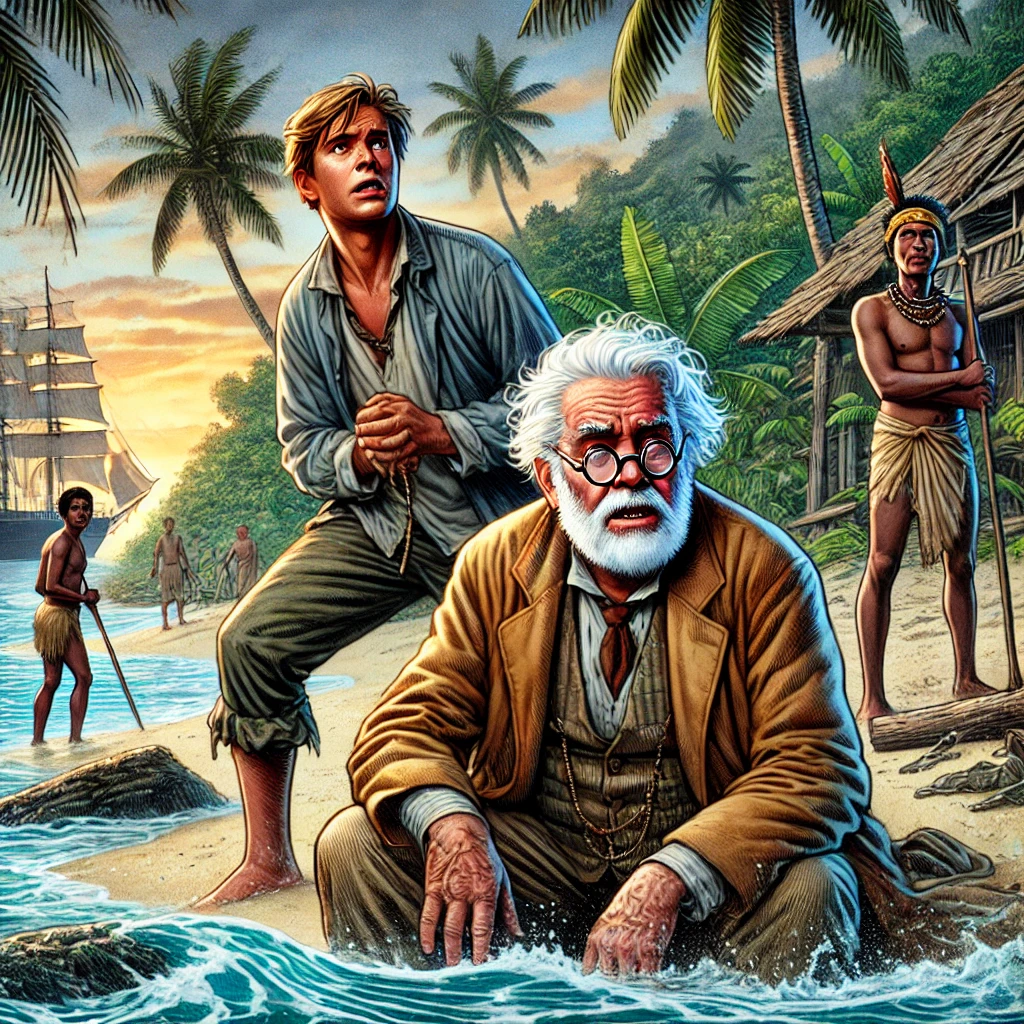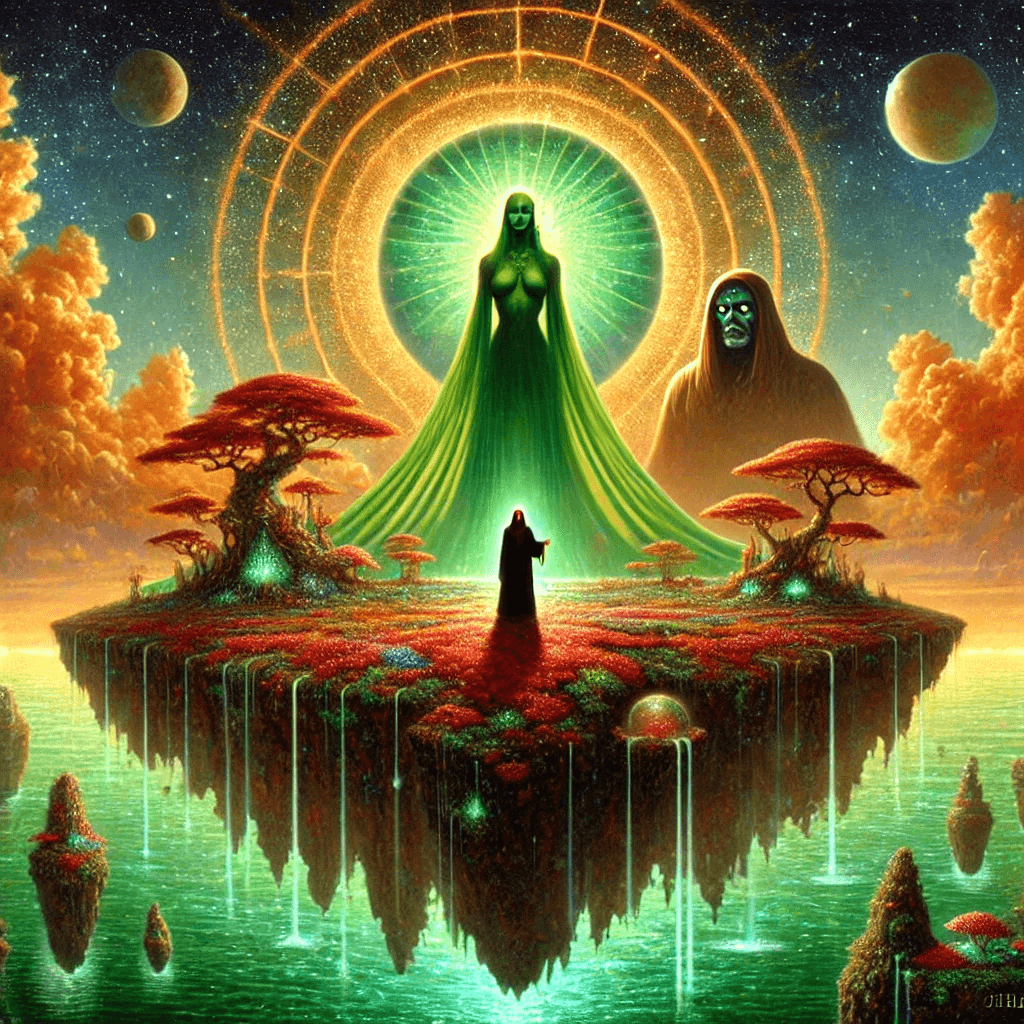Life, the Universe and Everything by Douglas Adams, published in 1982, is the third book in the beloved Hitchhiker’s Guide to the Galaxy series. This absurdist sci-fi comedy follows Arthur Dent and his companions as they confront a cosmic threat involving the planet Krikkit, interstellar cricket-playing robots, and the fundamental absurdity of existence.
Plot Summary
Arthur Dent, weary from years of quiet isolation on prehistoric Earth, begins his day in his cave with an early morning yell of horror, a ritual prompted by the desolate realization of his predicament. This serenity is abruptly interrupted when Ford Prefect, his erratic friend from Betelgeuse, arrives unannounced. Ford bears news of peculiar disturbances in the space-time continuum and a strange, inexplicable artifact—a velvet sofa floating lazily across the landscape. Urging Arthur to join him, Ford declares the sofa their ticket out of their mundane imprisonment.
Chasing after it with a mixture of glee and disbelief, Arthur and Ford leap onto the mysterious piece of furniture. Suddenly, reality twists around them, and they find themselves in the midst of a cricket match at Lord’s Cricket Ground, surrounded by a confused crowd. Before Arthur can fully appreciate the grass beneath his feet or the fleeting normalcy of the moment, chaos erupts. Slartibartfast, the elderly planetary designer who once crafted Earth’s fjords, appears and reveals the grim truth: a looming cosmic threat tied to the ashes of a cricket stump and a dark galactic history.
Long ago, the serene planet Krikkit remained untouched by the bustling activities of the universe due to its isolation. With a sky perpetually obscured by a dust cloud, the inhabitants of Krikkit knew nothing of the wider cosmos. One day, a stray spaceship crashed through their atmosphere, unveiling the vast, star-filled expanse beyond their shrouded world. This revelation led the people of Krikkit to an existential crisis. Their solution was chillingly simple: to erase the universe and restore the tranquility of their solitude. Thus began the Krikkit Wars, a relentless campaign of destruction led by hyper-efficient, cricket-themed robots. Though Krikkit was eventually defeated and locked away in a time bubble, the danger remains as a plot unfolds to release them.
Slartibartfast enlists Arthur and Ford in a mission to prevent the release of Krikkit and its killer robots. The trio journeys to the galaxy’s hidden corners aboard Slartibartfast’s bizarre spacecraft, powered by the revolutionary Bistromathic Drive, which operates on the strange and illogical mathematics of restaurant bills. Their pursuit leads them to uncover a plot involving the theft of the Ashes, a cosmic artifact integral to unlocking the time bubble imprisoning Krikkit.
The heroes soon discover that Trillian, the only other human survivor from Earth, has been investigating the theft. Reunited, the group encounters Zaphod Beeblebrox, the ever-reckless former Galactic President, whose antics add further chaos to their mission. Together, they traverse surreal locales, including an ancient, desolate spaceport and the dark heart of Krikkit itself, uncovering layers of intrigue and betrayal.
Amid their adventures, the group encounters Wowbagger the Infinitely Prolonged, an immortal being whose boredom with eternal life has led him to the peculiar pastime of insulting every living being in the universe—alphabetically, no less. Wowbagger’s bitterness provides a stark contrast to Arthur’s growing resilience, highlighting the weight of mortality and the fleeting joys of existence.
The journey crescendos with a confrontation on Krikkit as Arthur, Ford, Trillian, and Zaphod face off against the cricket-obsessed robots and the warped motivations of Krikkit’s inhabitants. The Ashes, imbued with great symbolic and literal power, are poised to break the time bubble and unleash chaos. Arthur, armed not with heroics but with wit and perseverance, plays a pivotal role in unraveling the scheme.
In the midst of peril, the group uncovers a greater cosmic truth: the interconnectedness of all events, even those shrouded in absurdity. As the time bubble teeters on the brink of collapse, the group’s actions lead to an unexpected resolution, blending cosmic irony with a glimmer of hope. Though Krikkit’s destructive past cannot be erased, its future holds the possibility of redemption.
Their mission complete, the companions part ways once more, each bearing the mark of their shared adventure. Arthur, ever the reluctant wanderer, reflects on the strange, improbable journey that continues to shape his understanding of life, the universe, and everything.
Main Characters
- Arthur Dent: The perpetually bewildered human protagonist, thrust into a universe where logic is upended. Arthur’s grounded perspective makes him a relatable lens through which the absurdities of the galaxy are explored.
- Ford Prefect: Arthur’s alien friend and guide through galactic insanity, Ford thrives on chaos and maintains a mix of irreverence and wry wisdom.
- Slartibartfast: A philosophical planetary designer, he returns to aid Arthur and Ford, embodying a mix of gentle humor and earnestness as he warns of impending doom.
- Trillian: A brilliant and pragmatic human who remains calm under pressure, adding emotional depth and resourcefulness to the team.
- Zaphod Beeblebrox: The egotistical, two-headed ex-President of the Galaxy who exudes charm, selfishness, and unpredictability, keeping things delightfully off-kilter.
- Wowbagger the Infinitely Prolonged: An immortal being on a bizarre mission to insult everyone in the universe, serving as a darkly comedic commentary on the burden of eternal life.
Theme
- The Absurdity of Existence: The novel revels in the illogical, emphasizing the nonsensical yet oddly meaningful patterns of life and the universe.
- Mortality and Immortality: Characters wrestle with the meaning of existence, contrasting finite human lives with the ennui of eternal beings.
- Satire of Human Institutions: Adams parodies human systems like bureaucracy and organized sports (via galactic cricket), highlighting their inherent absurdities.
- Interconnectedness and Chaos: The plot underscores how even the smallest actions ripple outward, shaping the cosmos in unexpected ways.
- Curiosity and Exploration: The narrative celebrates the joys and perils of discovery, as characters seek knowledge while confronting existential dilemmas.
Writing Style and Tone
Douglas Adams’ writing is marked by a blend of intellectual humor, linguistic inventiveness, and sharp satire. His signature style includes seemingly irrelevant digressions that ultimately tie back to the plot in ingenious ways, creating a narrative that feels both sprawling and meticulously crafted.
The tone is irreverent, playful, and at times philosophical. Adams’ mastery of wit ensures that even the most mundane details sparkle with humor, while his subtle explorations of deeper themes add richness to the text. The juxtaposition of the ludicrous and the profound makes the story uniquely engaging.
We hope this summary has sparked your interest and would appreciate you following Celsius 233 on social media:
There’s a treasure trove of other fascinating book summaries waiting for you. Check out our collection of stories that inspire, thrill, and provoke thought, just like this one by checking out the Book Shelf or the Library
Remember, while our summaries capture the essence, they can never replace the full experience of reading the book. If this summary intrigued you, consider diving into the complete story – buy the book and immerse yourself in the author’s original work.
If you want to request a book summary, click here.
When Saurabh is not working/watching football/reading books/traveling, you can reach him via Twitter/X, LinkedIn, or Threads
Restart reading!


